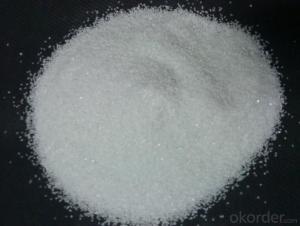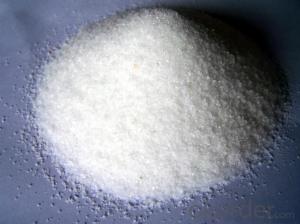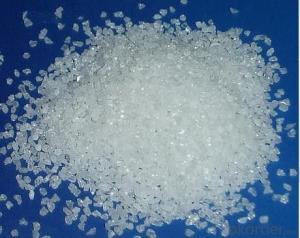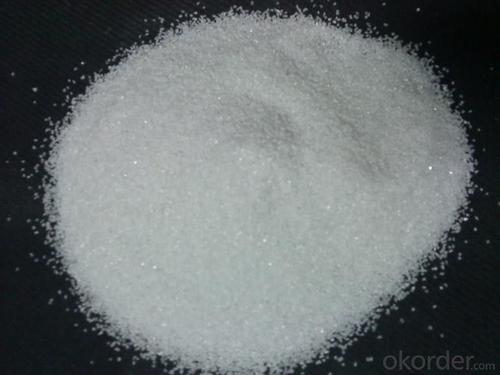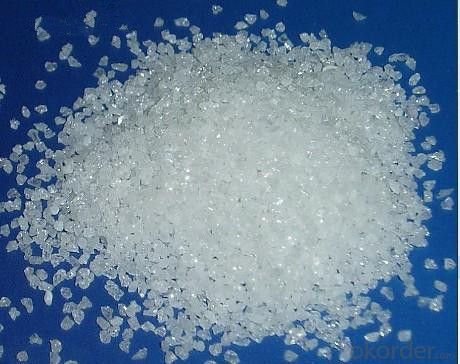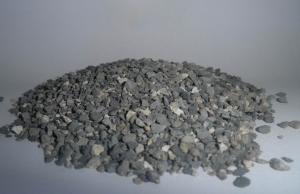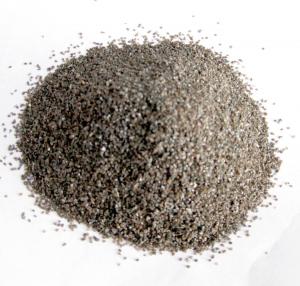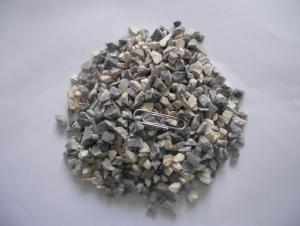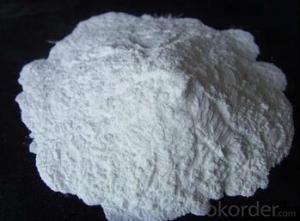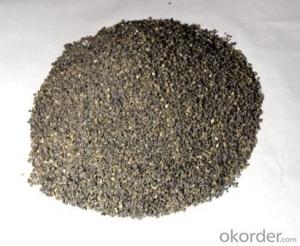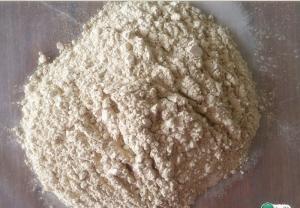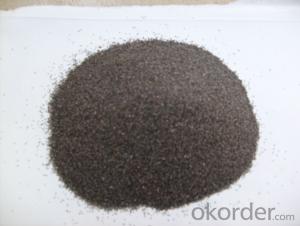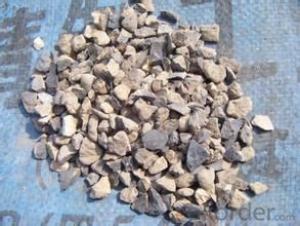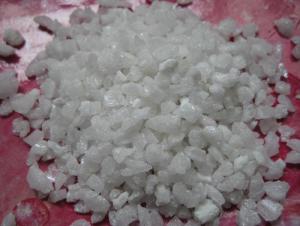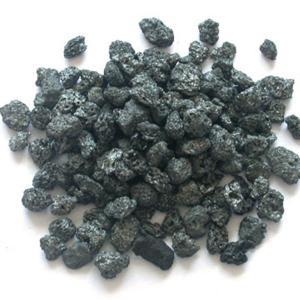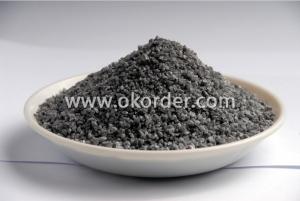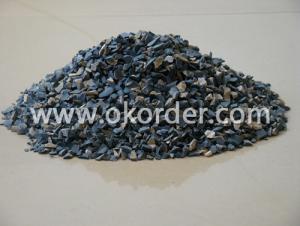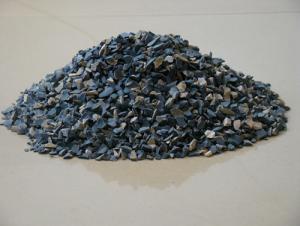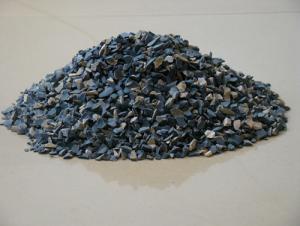Raw Materials for Refractory - Abrasive White Fused Alumina 99.05
- Loading Port:
- Tianjin
- Payment Terms:
- TT OR LC
- Min Order Qty:
- -
- Supply Capability:
- 1000MT m.t./month
OKorder Service Pledge
Quality Product, Order Online Tracking, Timely Delivery
OKorder Financial Service
Credit Rating, Credit Services, Credit Purchasing
You Might Also Like
Specification of Abrasive White Fused Alumina
Item | Chemical Composition | |||
Al2O3 min | NaO2 max | SiO2 max | Fe2O3 max | |
12#-60# | 99.15 | 0.26 | 0.08 | 0.05 |
60#-100# | 99.15 | 0.28 | 0.09 | 0.06 |
120#-150# | 99.1 | 0.29 | 0.10 | 0.08 |
180#-220# | 99.05 | 0.31 | 0.12 | 0.1 |
230#-800# | 98.5 | 0.5 | 0.15 | 0.1 |
1000#-1200# | 98.1 | 0.6% | 0.18 | 0.1 |
Packaging & Shipping
In 1MT jumbo bag or as the buyer request.
We ship the cargo in 20' GP containers,each container loads 25MT/20bags.
Application of white fused alumina
Made of abrasive, suitable for grinding hardened alloy steel, high speed steel. Fine-grained flour is also used for precision casting.
- Q: what is the grading standards of external wall thermal insulation materials?
- 1. combustion performance of insulation material rates A EPS sea capacity module, rock wool, glass wool, foam glass, ceramic foam, foam cement, perlite obturator, etc. 2. combustion performance of insulation materials rates B1 Extruded polystyrene board (XPS) after special treatment / Special treatment of polyurethane (PU), phenolic aldehyde, gelatine powder polyphenyl granule3 combustion performance of insulation material rates B2 Molded polystyrene board (EPS), extruded polystyrene board (XPS), polyurethane (PU), polyethylene (PE), etc. See the 2009 edition construction technical measures 4.3.6 A graded insulation material is fire proof, but its thermal insulation performance is not so as organic XPS \ EPS. I feel the best insulation materials are Hairong EPS module. it is both insulating and fireproof and cheap. Insulation materials in the domestic market each has its shortcomings. Choose of materials should based on actualities in construction.
- Q: What characteristics do A grade external wall fireproofing material have?
- 1. Save space and reduce costs; 2. Fireproofing, green and environmental protection; 3. Waterproofing; 4. Sound insulation; 5. Thermal insulation; 6. Install easily and shorten the construction period; 7. High safety performance.
- Q: I wanna ask you, which level is b1 fireproof and thermal inuslation matertial ??
- which level is b1 fireproof and thermal inuslation matertial: I soppose you mean rubber and plastic! Only rubber and plastic has b1b2 level. Level b1 is the fireproofing level b1, because the rubber and plastic does not belong to the fireproofing material. It only has fire?retardant. The wholesale of all kinds of thermal insulation material and construction needs to look at the name.
- Q: What is fireproofing material? Are fireproof materials the same thing with thermal insulation materials and refractories?
- Insulation materials. Thermal insulation material is characterized by thermal insulation, which is one of the four traditional inorganic nonmetallic materials. Fire?retardant material is cahracterized by heat-resistant. Refractory is a kind of materials of resisit high temperature. Fireproof material, which is different from thermal insulation material and refractory, is a synthetic material with some fireproof subtrate added. It is essentially resistant to high temperature.
- Q: How should refractory cement be used?
- Insulation fire mortar: It is used as a protective refractory layer in the kiln head burner, as a refractory material in some parts of preheater, and it is generally constructed by grouting. b: Insulation fire mortar: It is used to repair the deformed plane of the kiln shell, or for thermal insulation of the roof in the cooler. Refractory mortar: It is also known as thermosetting fire mortar, mainly used in brick masonary. When using, we must add the glassy water to stir. (silicic acid sodium, water, NaSiO3, H2O).
- Q: What are the specific steps of stirring the steel ladle castable?
- Steps are as follows. 1 Compulsory mixer is used to stir the castable and bags, rope and other debris can not mix in the castable when stirred. 2, Castable should be unpacked on the scene. Stirred volume depends on the capacity of the mixer. Castable should be accurately measured and put into a blender. 3 The process of first dry mixing and then wet mixing is adopted. After the castable is added to the mixer, it is dryly mixed for 2 minutes, add about 5.2 to 5.5 percent of water and continue to add water while stirring. Water that is 80% of the total should be added, and then decide whether to continue to add or not depending on the consistence (noting that the water must be clean water and sewage can not be used). Then it is wetly mixed for 4 minutes and stirred for not less than 6 minutes at one time, until castable is even. In general, the bottom is slightly dry and the wall of the ladle is slightly dilute (the amount of water is only for reference). 4, The amount of water and mixing time should be controlled strictly when stirred to ensure that the needs of the consistency are met. If castable is too thin, it will seriously affect the quality of the material. The stirred volume, stirring time and water that is added should be consistent and they can not suddenly be thick or suddenly be thin. If the consistency does not meet the requirements, the castable should be put back to the mixer and stirred with appropriate water or dry materials. 5, It should be stirred evenly and casting should finish in 20 minutes, in order to avoid sclerosis, affecting structural strength of ladle lining 6, After each completion of construction, varieties of castable should be changed and the mixer should be cleaned 7, Stirring can stop in halfway. If the mixer breaks down and it can be repaired in a short time, some of the materials have to be removed before the machine is opened. If the machine can be repaired on time, castable refractory should all be removed.
- Q: What's the difference of fire-resistant material's density, specific gravity and bulk specific gravity?
- It usually used to test lightweight refractory. Density can be divided into apparent density (usually called as density) and true density: apparent density includes blow hole inside the sample; Unit weight is using quality to divide volume of sample and specific weight is used to represent liquid.
- Q: What are the classifications of refractory? Which category does steel ladle castable belong to?
- Silmo brick, alumina-magnesia brick; 2. coke oven, aluminum silicate... 8 categories)& nbsp, teeming ladle, glass furnace ...... 7 categories) high alumina refractory products (blast furnace, electric furnace, cement kiln, magnesia, glass furnace; 3. high alumina refractory mortar (high alumina, glass kiln ...... 6 categories) special refractory products (magnesia-carbon bricks, aluminum-carbon bricks, MgO-C, shapeless refractory products& nbsp, light weight, sliding plate bricks, cement kilns: There are 26 categories in refractory products, clay, calcium silicate, ceramsite lightweight... 10 categories) & nbsp, air heating furnace, sheets; 1 refractory castable (alumina-magnesia, blocks, resistance furnace... 11 categories) alkaline refractory products (magnesia. First, thermal insulation refractory products (ceramic fiber; clay, diatomaceous earth, steel fibre reinforcement...14 categories) & nbsp, silicon carbide brick ...... 19 categories) Second, China is the largest refractory production country in the world, clay, non-water cannons mud, converter, siliceous, teeming ladle, profiled) siliceous refractory products (coke oven, dense shaped refractory products (all kinds of bricks, electric furnace roof, glass kiln ...... 5 categories) clay refractory products (blast furnace, high alumina ...... 4 categories) three
- Q: What is neutral refractory? Can refractory suppliers tell the main components of it?
- // Baike? Url x3d CQ3i6_yUCWUMgk3aaRGGLURNtvKPl5IdZpj35Yvommk7Nyif0IJD-SkdIW29GCHwLpb9cT9Ii25GLcEJg-ZHcq "target x3d" _blank "x26gt; http://baike.baidu.baidu.
- Q: What is fire retardant coating mainly used for?
- Fire retardant coating is a coating which is applied to the surface of buildings and structures and can form a protective layer of fire retardancy and thermal insulation. It can reduce the flammability of the coated materials and block the rapid spread of fire so as to improve fire endurance of the coated materials. Features of fire retardant coating: (1) Fire retardant coating itself has a flame-retardancy or non-inflammability, and it can prevent the protected substrate from direct contact with the air, and delay ignition and reduce the burning speed of the objects. (2) In addition to flame retardancy or non-inflammability, the fire retardant coating itself has a a low thermal conductivity, which can delay the transfer of flame temperature to the substrate to be protected. (3) When heating, fire retardant coating decomposes non-combustible inert gas to dilute the combustible gas decomposed by the protected, making it difficult to burn or slow down the burning rate. (4) Fire retardant coating containing nitrogen will decomposite NO, NH3 and other basic groups, which compound with the organic radicals and interrupt the chain reaction so as to reduce the temperature. (5) intumescent fire retardant coating will expand and foam when heating, and form a carbon foam insulation to block the protected objects, thus delaying the transmission of heat to the substrate.
Send your message to us
Raw Materials for Refractory - Abrasive White Fused Alumina 99.05
- Loading Port:
- Tianjin
- Payment Terms:
- TT OR LC
- Min Order Qty:
- -
- Supply Capability:
- 1000MT m.t./month
OKorder Service Pledge
Quality Product, Order Online Tracking, Timely Delivery
OKorder Financial Service
Credit Rating, Credit Services, Credit Purchasing
Similar products
Hot products
Hot Searches
Related keywords
